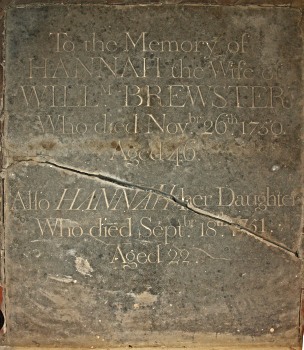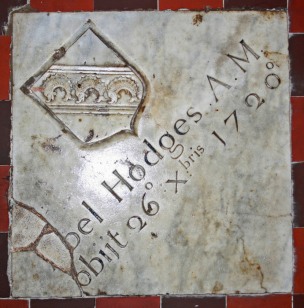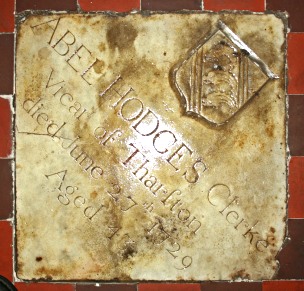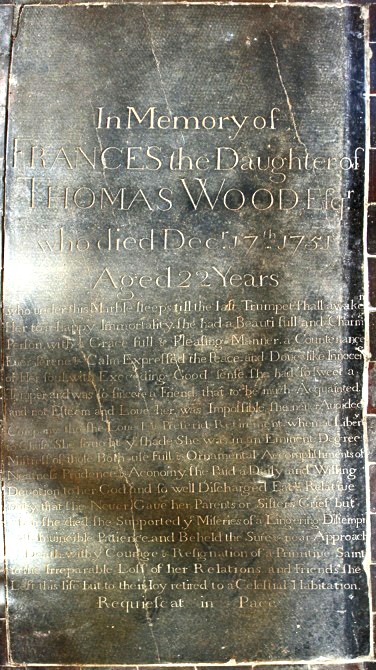
Hidden Memorials in St. Mary’s Church, Tharston


Hidden Memorials in St. Mary’s Church, Tharston



Whilst undertaking some interior repairs the altar had to be moved and having removed the carpeting three stones were found. To date very little information has been found relating to the Hannah Brewster or any other Brewster in Tharston but the positioning of the stone must mean they were quite an eminent, and affluent, local family. The only possible Brewster references are for the marriage on 3rd December 1781 of Judith Brewster to Henry Bunn and of the baptisms of their children.
Internet research shows that three generations of Hodges were the Vicar of Tharston, all with the forename of Abel. At the Restoration in 1661, Abel Hodges, A. M. held the living linked with Tibenham. In 1678, Abel Hodges, A. M. succeeded as vicar upon his father's death. Upon his death in 1720, Abel Hodges his son held it first linked with Wacton-Parva and later with Brockdish until his death in 1729. More details on the early vicars of Tharston are available on the British History Online in the section on Hundred of Depwade and Tharston
Interestingly the A.M. after the elder Abel Hodges’ name is thought to be “Artium Magister” the latin equivalent to the university degree now M.A. or Master of Arts. The same is found after the name of the Abel Hodges who preceeded the two commemorated by the stones. The word “Clerke” after the younger Abel’s name is probably a derivative word from the Latin clericus, meaning a man in Holy Orders.
In Paul Cattermole’s description of the interior of St. Mary’s it speaks of “two small lozenges of white marble, commemorating a father and son, both called Abel Hodges, who were 18th-century vicars of Tharston, recorded by Tom Martin c. 1735, have disappeared”. We now know where they were hiding!

The inscription reads:
In Memory of
FRANCES the Daughter of
THOMAS WOOD Esqr
who died Decr 17th 1751
Aged 22 Years
who under this Marble sleeps till the last Trumpet shall awaken
Her to a Happy Immortality. She had a Beautifull and Charmg
Person. with a Grace full and Pleasing Manner. a Countenance
Ever serene & Calm Expressed the Peace and Dove like Innocene
of Her Soul with Exceeding Good Sense. She had so sweet a
Temper and was so sincere a Friend that to be much Acquainted
and not Esteme and Love her was Impossible. She never Avoided
Company tho she Loved & Preferid Retirement when at Liberty
to Chuse. She fought ye * shade She was in an Eminent Degree
Mistress of those Both usefull & Ornamental Accomplishments of
Neatness Prudence & Aconomy. She Paid a Daily and Willing
Devotion to her God and so well Discharged Each Relative
Duty that she Never Gave her Parents or Sisters Grief but
when she died. she supported ye * Miseries of a Lingering Distempi **
with Invincible Patience and Beheld the Sure & near Approach
of Death with ye * Courage & Resignation of a Primitive Saint
to the Irreparable Loss of her Relations and Friends she
Left this life but to their Joy retired to a Celestial Habitation.
Requiescat in Pace ***
Notes on the wording:
* ye or y - abrieviation for "the" - alteration of Middle English þe the, from Old English þē; from the use of the letter y by printers and scribes of late Middle English to represent þ (th) of earlier manuscripts
** Distempi - latin: literally "not in this time" - illness, absence of mind
*** Requiescat in Pace - latin: Rest in Peace
The inscription, being so long, must have cost a great amount to have carved, again indicating that the family would have been quite wealthy. Frances died relatively young, having suffered ill health. We also know that she had sisters. There is no reference to her burial in the Tharston burial records.
Page last updated: 4 Jan 2024
© Nigel Peacock 2024